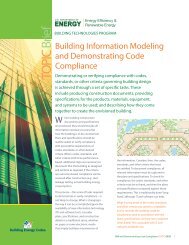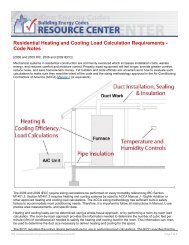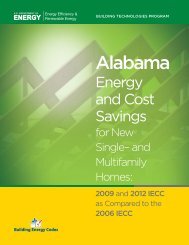Shaping the Energy Efficiency in New Buildings - Building Energy ...
Shaping the Energy Efficiency in New Buildings - Building Energy ...
Shaping the Energy Efficiency in New Buildings - Building Energy ...
You also want an ePaper? Increase the reach of your titles
YUMPU automatically turns print PDFs into web optimized ePapers that Google loves.
efficient air condition<strong>in</strong>g system, for example, if <strong>the</strong> total designed energy use fallswith<strong>in</strong> <strong>the</strong> required norms. There are several approaches to establish<strong>in</strong>g <strong>the</strong> basel<strong>in</strong>e forcomparison under <strong>the</strong> build<strong>in</strong>g energy performance method. The United States uses costas its reference metric, while some o<strong>the</strong>r countries base <strong>the</strong> reference metric on energyconsumption.South Korea and Japan take a different approach, establish<strong>in</strong>g both mandatoryrequirements and a po<strong>in</strong>t system for a whole range of energy issues related to build<strong>in</strong>gs.Each new build<strong>in</strong>g must have a m<strong>in</strong>imum number of po<strong>in</strong>ts ei<strong>the</strong>r <strong>in</strong> total or by category.Build<strong>in</strong>gs that exceed <strong>the</strong> m<strong>in</strong>imum po<strong>in</strong>t requirement may be eligible for certa<strong>in</strong> benefits,such as relaxation of some zon<strong>in</strong>g rules.Enforcement SystemsEnforcement is critical for <strong>the</strong> standard to have an effect. Not all countries havemandatory build<strong>in</strong>g energy standards. India, for example, has a voluntary code. Japan’sstandards are also technically voluntary, although Japan has recently adopted penaltiesfor non-compliance that blur this dist<strong>in</strong>ction. The United States, Canada and Australia alladopt build<strong>in</strong>g standards at <strong>the</strong> local level. Not all jurisdictions <strong>in</strong> <strong>the</strong> United States andCanada have adopted <strong>the</strong>ir nation’s model build<strong>in</strong>g energy codes. Ch<strong>in</strong>a has mandatorynational codes, but prov<strong>in</strong>ces have <strong>the</strong> option to adopt more str<strong>in</strong>gent local codes.Some important issues regard<strong>in</strong>g enforcement and <strong>the</strong> related impact of <strong>the</strong> code onenergy use <strong>in</strong>clude: <strong>the</strong> po<strong>in</strong>t of compliance (design and/or construction stage), howbuild<strong>in</strong>gs are reviewed or <strong>in</strong>spected and by whom, penalties and o<strong>the</strong>r <strong>in</strong>centives forcompliance, tra<strong>in</strong><strong>in</strong>g and <strong>in</strong>formation on <strong>the</strong> code, compliance tools such as codecompliance software and <strong>in</strong>spection checklists, and equipment and material test<strong>in</strong>g andrat<strong>in</strong>gs.In <strong>the</strong> United States, Canada, Australia and South Korea, for example, <strong>the</strong> build<strong>in</strong>gdesign must be approved, and <strong>in</strong>spectors check <strong>the</strong> build<strong>in</strong>g for compliance at least oncedur<strong>in</strong>g construction. In Japan, <strong>the</strong> reviews only occur at <strong>the</strong> build<strong>in</strong>g design stage. Ch<strong>in</strong>auses a comb<strong>in</strong>ation of government employees and certified companies to check build<strong>in</strong>gdesigns and <strong>in</strong>spect <strong>the</strong> build<strong>in</strong>gs for compliance. There is no s<strong>in</strong>gle answer as to whichsystem produces <strong>the</strong> highest level of compliance. For example, Japanese officials believethat Japan atta<strong>in</strong>s a high level of compliance <strong>in</strong> actual construction because Japan has avery well developed system of tra<strong>in</strong><strong>in</strong>g and <strong>in</strong>formation dissem<strong>in</strong>ation on <strong>the</strong> build<strong>in</strong>genergy standards. Anecdotal evidence <strong>in</strong> <strong>the</strong> United States and o<strong>the</strong>r countries <strong>in</strong>dicatesthat <strong>in</strong>spections do play an important role <strong>in</strong> atta<strong>in</strong><strong>in</strong>g high levels of compliance. The U.S.Department of <strong>Energy</strong> is now develop<strong>in</strong>g methodologies to measure and trackcompliance.The str<strong>in</strong>gency of <strong>the</strong> national system for test<strong>in</strong>g materials and equipment for <strong>the</strong>ir energyefficiency properties can also have a marked impact on <strong>the</strong> f<strong>in</strong>al energy consumption of abuild<strong>in</strong>g. Most countries have a system of certified laboratories that test materials andequipment (like w<strong>in</strong>dows and air conditioners) and rate <strong>the</strong>m for efficiency. These rat<strong>in</strong>gs6
















